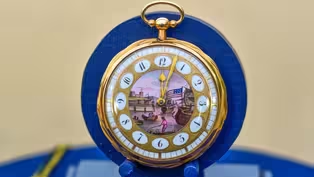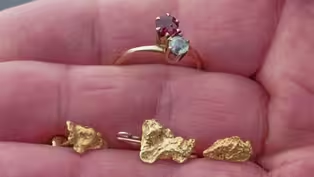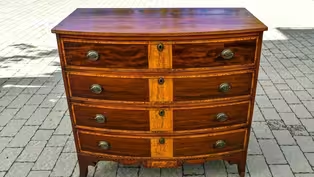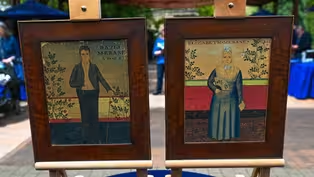
Appraisal: WWII Japanese Internment Camp Art
Clip: Special | 7m 6sVideo has Closed Captions
Appraisal: WWII Japanese Internment Camp Art
Check out Jeff Shrader's appraisal of WWII Japanese internment camp art in RECUT: Idaho Botanical Garden, Part 3.
Problems playing video? | Closed Captioning Feedback
Problems playing video? | Closed Captioning Feedback
Funding for ANTIQUES ROADSHOW is provided by Ancestry and American Cruise Lines. Additional funding is provided by public television viewers.

Appraisal: WWII Japanese Internment Camp Art
Clip: Special | 7m 6sVideo has Closed Captions
Check out Jeff Shrader's appraisal of WWII Japanese internment camp art in RECUT: Idaho Botanical Garden, Part 3.
Problems playing video? | Closed Captioning Feedback
How to Watch Antiques Roadshow
Antiques Roadshow is available to stream on pbs.org and the free PBS App, available on iPhone, Apple TV, Android TV, Android smartphones, Amazon Fire TV, Amazon Fire Tablet, Roku, Samsung Smart TV, and Vizio.
Buy Now
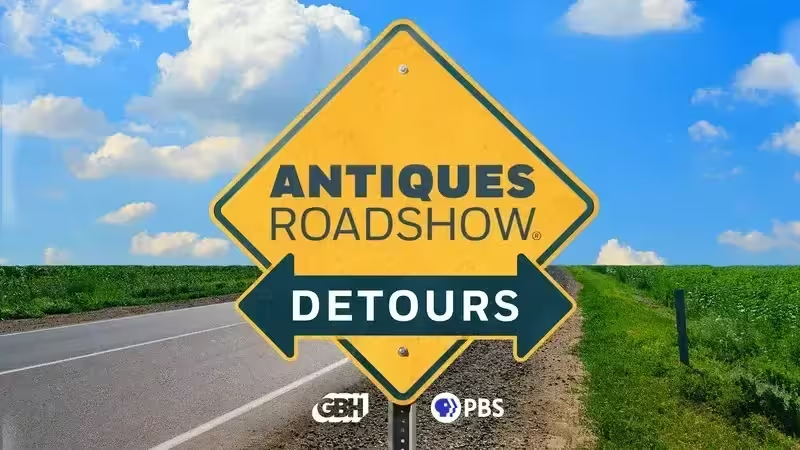
ANTIQUES ROADSHOW DETOURS
Ever wondered what happens to the treasures featured on America’s beloved ANTIQUES ROADSHOW after the cameras leave town? Host Adam Monahan tracks down the juicy afterlives of your favorite finds from PBS’s hit series.Providing Support for PBS.org
Learn Moreabout PBS online sponsorshipGUEST: I brought this pin that my Uncle Shiro made in the internment camp at Poston.
That's my uncle right there, Shiro.
My mom received this pin from Shiro, who is her brother-in-law, and she gave it to me.
And then I had it framed, with the story and the picture of, of the camp.
The other thing I have is this picture of him receiving his internment orders from this soldier.
APPRAISER: Did you know your uncle?
GUEST: No, he passed in, um, 1956.
APPRAISER: Tell us what's happening in this photo.
GUEST: He was living on Terminal Island.
That was located in California.
The soldier right there with the bayonet is giving the order to my uncle that they have to evacuate the island and go to the internment camp.
I wonder what he's thinking as he's, as he's reading this.
APPRAISER: So when he was asked to leave, it wasn't to relocate 20 miles down the road.
GUEST: No.
APPRAISER: They took him all the way to Yuma.
GUEST: Yes.
I've researched the National Archives, and they said that he was in the relocation camp from 1942 to 1946.
I'm a Sansei, which is three generations.
And I wasn't born during this period.
And I read this book... Um... (voice trembling): And it was very hard to read, um... (clears throat) A lot of the Japanese received 48 hours or so to get their belongings and leave.
And some of the men left and the women stayed with the children.
My paternal grandparents and my maternal grandparents were too far inland, so they were not interred.
(sniffles) APPRAISER: Were they treated with respect by their fellow Americans?
GUEST: No.
(sighs) When the war happened, they were asked to leave the church.
And another thing that happened, my mother, and my grandmother and grandfather, had a farm in a small town in Utah.
And... She heard all this noise.
(sniffs) And she walked out.
(voice trembling): And, um, there were some men in white sheets, and they're trying to push my grandfather's tractor into the lake.
And my grandmother tried to stop them, and they pushed her down.
I d...
It's really hard for me to understand that hatred, or fear, or, or whatever emotions it was.
Their house was egged.
One of the teachers, um, taught the kids to say, "Go home..." I can't even say the word.
Um, in Spanish.
And she was the only Japanese in the class.
My mom said that if she were in a relocation camp, they probably would have been safer.
(sniffs) APPRAISER: From tragedy, sometimes, comes art.
And that's what we have here.
What do you know about this?
GUEST: We believe that my uncle created it out of sagebrush, and they had paints.
And if you can see, he painted it.
It's amazing.
APPRAISER: Internment camp artwork is not exclusive to the experience of the Japanese Americans in the Second World War.
This is something that militaria collectors, trench art collectors, see going back through time.
Really, where you see the most of it is in the First World War.
I find it interesting that this artwork that we see represented typically reflects the culture of those who are in that circumstance.
So what we see here is the cultural tradition of Japan as it is manifested in internment camp artwork.
The level of detail is beautiful.
GUEST: Mm-hmm.
APPRAISER: It's really pretty exquisite.
And it is interesting that it's a way to cope...
GUEST: Mm-hmm.
APPRAISER: ...with being in an intolerable circumstance.
GUEST: Mm.
APPRAISER: Make something beautiful out of something that is not beautiful at all.
The way that we disrespect one another.
These are American citizens.
GUEST: Mm-hmm.
APPRAISER: And that's what made this so particularly heinous within the way that we look at history.
The artifact clearly has emotional significance to you.
GUEST: Yes.
APPRAISER: It has cultural significance to the Japanese American community.
GUEST: Yes.
APPRAISER: And because of that, when these do come up for sale, there is often offense taken.
I like to tell folks that there are three major components of the system that saves history.
There's the family, who decided that something was worth saving.
And then there are museums that can curate a tiny percent of what needs to be saved.
And then there's the collecting community that steps in to do the rest.
GUEST: Mm-hmm.
APPRAISER: So we all work together to make sure that history is saved.
Artifacts are conduits to the past.
It's a touchstone.
Every time you look at this, you're feeling what happened...
GUEST: Mm-hmm.
APPRAISER: ...to your family.
And I think everybody else who looks at these things, when they see them, because they know the story, they can share in that and empathize with you.
And that is really...
There's the building blocks of making sure that we respect one another as human beings, and we don't let things like that happen again.
If one of these was to come up for sale, I would expect to see a retail value of $1,000 to $1,500.
GUEST: It's priceless to me.
It's interesting how things haven't really changed that much.
I'm Japanese American.
But I'm a person.
My mom is 95, and she still has a deep, sad feeling.
Appraisal: French Musical Pocket Watch, ca. 1830
Video has Closed Captions
Clip: Special | 3m 40s | Appraisal: French Musical Pocket Watch, ca. 1830 (3m 40s)
Appraisal: Idaho State Gems & Gold Nuggets, ca. 1905
Video has Closed Captions
Clip: Special | 1m 26s | Appraisal: Idaho State Gems & Gold Nuggets, ca. 1905 (1m 26s)
Appraisal: New Hampshire Federal Chest of Drawers, ca. 1800
Video has Closed Captions
Clip: Special | 3m 36s | Appraisal: New Hampshire Federal Chest of Drawers, ca. 1800 (3m 36s)
Appraisal: Portraits Attributed to Guilford County Limner
Video has Closed Captions
Clip: Special | 3m 4s | Appraisal: 1826 Portraits Attributed to Guilford County Limner (3m 4s)
Providing Support for PBS.org
Learn Moreabout PBS online sponsorship
- Home and How To

Hit the road in a classic car for a tour through Great Britain with two antiques experts.













Support for PBS provided by:
Funding for ANTIQUES ROADSHOW is provided by Ancestry and American Cruise Lines. Additional funding is provided by public television viewers.


